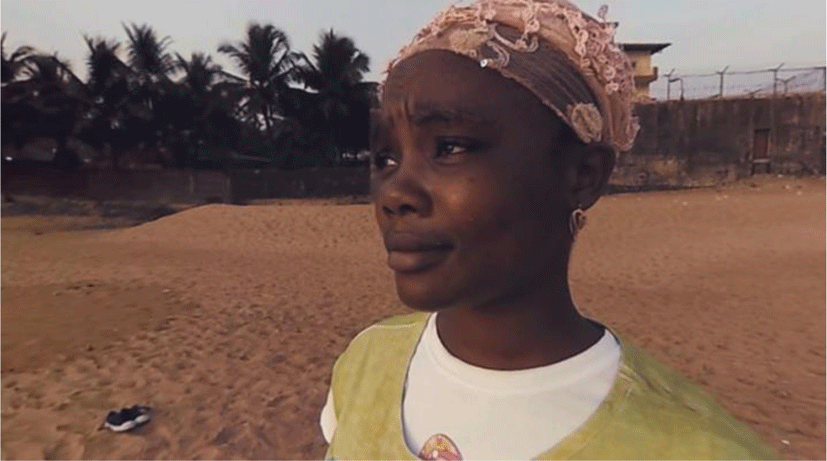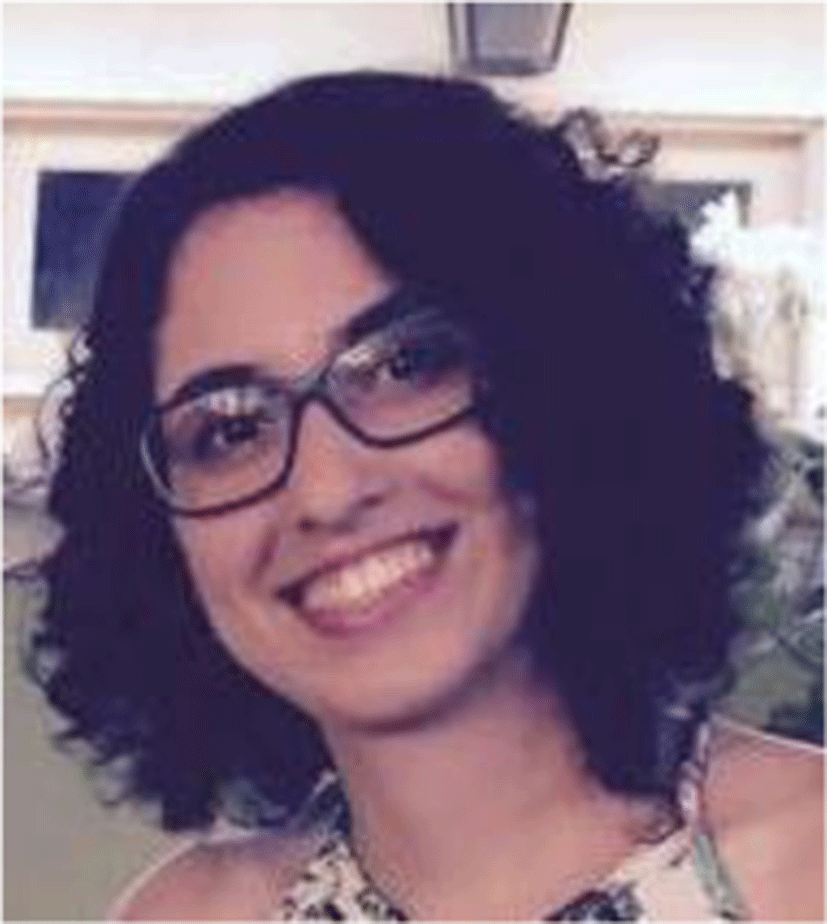I. INTRODUCTION
Documentary, a media known for its representation of real facts [1], has had its long-studied characteristics somewhat transformed since the arrival of Virtual Reality. VR is broadly referred to as an ‘empathy machine’, it is able to go beyond other types of media and “capable of transcending the limits of representation” [2]. Much of this is due to its illusion of presence, since the user is inserted in a virtual environment, rather than simply looking at a screen. This quote directly contrasts with documentary’s core meaning of representing reality, but does VR in its present state actually surpasses representation? This will be discussed in more depth later in this paper.
VR technology is evolving fast, and, specially in the last five years, has received a lot of attention, mostly from the game industry. However, it is also growing in the documentary field: The project VR Documentary Encounters, created by the University of Bristol, University of Bath, University of West of England Bristol, and the Engineering and Physical Sciences Research Council (EPSRC), has 572 non-fiction VR productions catalogued in their database, starting from 2012 until 2018 [3]. It is a significant number for a technology that has just recently gone mainstream.
The immersive special environment generated by VR leads to unique experiments related to morality and how it can affect users. Humanitarian documentary, the object of this study, was chosen for being the most sensitive example of this type of media, as it is always trying to compel a moral reaction of viewers, be it VR or non-VR. Therefore, this study aims to answer the following research question: How different does VR portray non-fictional stories, specially of people in harsh living situations, such as those in refugee camps, when compared to non-VR? While answering this question, the article also examines what are the uses of VR in non-fiction and its advantages and disadvantages when filming. It also focuses on the challenges of working with a new technology such as VR, as opposed to the ones established for many years, when dealing with non-fiction. This paper targets these productions’ narrative style through the use of different film techniques and tools, rather than on mechanical or mathematical aspects of VR head-mounted displays (HMD).
This article, besides its previously mentioned objectives, aspires to aid VR non-fiction content creators from a filming standpoint. It is also part of a work in progress thesis on VR non-fiction. Its secondary objective is to assist on the production of a VR documentary made as an experiment for this thesis, by helping identify the difficulties and technicalities when filming for VR media.
II. HUMANITARIAN COMMUNICATION AND ITS CHARACTERISTICS
Humanitarian media often relies on “showing” the disasters first hand. Be it using interviews and testimonies, humanitarian media’s aim is to inform what is happening in different sides of the world. Frequently searching to generate an empathetic response on viewers, this type of communication attempts to be very persuasive, and relies on the use of powerful imagery. A good example that contains these characteristics is the <Most Shocking Second a Day Video> released in 2014 by the organization SaveTheChildren. It is a short charity advert that shows a once happy child that lived normally having her life destroyed due to war. The content is emotional and intense, and to appeal to a western public, the creators chose a western setting, western actors and the main character is a little white girl, a clear attempt to make the target audience empathize more with the subjects (see Figure 1). The video went viral and as of this writing has almost 63 million views on Youtube, which led to a continuation of the short story called <Still the Most Shocking Second a Day> being released in 2016. This dramatization using westerners proved to be very effective, while still conveying the real situations that Syrian refugees had to go through.
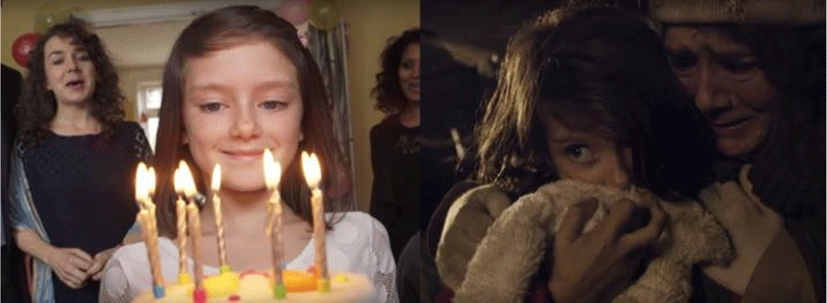
Even though the <Most Shocking Second a Day Video> was a short film with fictional characters, humanitarian documentaries tend to follow a similar manner of addressing issues. They usually display women and children instead of grown men, with the intention of showing vulnerability and generate a sense of need for protection. Not only that, but when representing refugees, they are often cast as “invisible, speechless, and nonpolitical” [4]. This method attempts to portray the refugees as detached from the conflicts, not as part of any army, but as common citizens that became victims because of war.
However, the types of productions can vary in their approach. In <A Day in the Life: Za'atari 2013> for example, the focus is on the life of both refugees and workers of NGOs (UNHCR), and how their relationship works inside the camp. There are problems on how resources should be shared, and it is up to the NGO volunteers to try and solve them. This documentary focuses specifically on portraying the rush of being in a recently built camp, where materials and food are scarce. This can lead to heavy discussions and disagreements between the people that live there.
Going in a completely different direction, the <Another Kind of Girl Collective> (AKGC) is a collection of videos made by girls who live in displaced communities. The project gives these girls the equipment necessary so they can show their communities however they desire. It started with 17-year-old Khaldiya, in 2015, where she shows the Za’atari camp, the same camp from the previous mentioned documentary, from her perspective, being able to give a more intimate look into the situation. When seeing both side by side, as in Figure 2, it’s possible to notice the difference between a more crowded, agitated environment during an interview, contrasting with a girl alone, smiling at her camera.

However different these approaches to displaying the life of refugees may be, they still share important characteristics: all of them gather attention to the lives of these people, humanize them, and hopefully raise awareness to get assistance from other parts of the world.
III. THE REALITY OF HUMANITARIAN VR: NEW VARIATIONS IN THE GENRE
Differently than non-VR documentary, VR allows viewers to choose where to look, or where to not look, minimizing the mediated experience. Usually, it creates the sensation that everything happens onscreen, without any direction happening on part of the creators. In <7 Stories for 7 Years - Stories After Syria 2018>, a short documentary that shows the lives of young Syrians 7 years after moving to the Za’atari camp, the viewer hears narration spoken by a westerner and by the refugees, and sees images recorded by the refugees. The viewer is free to look around, what creates the sensation of raw footage (See Figure 3).
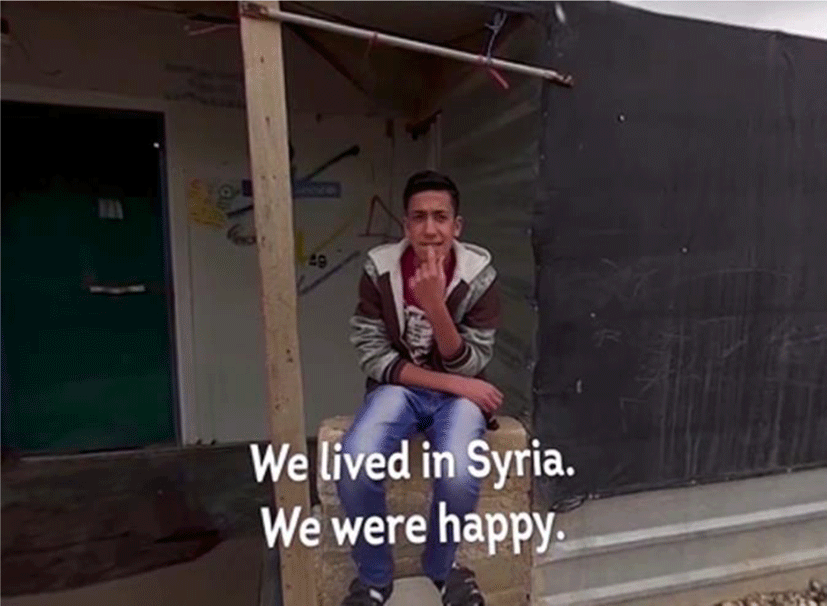
Through this “all onscreen” mechanism, viewers are able to have a more realistic perceptual experience, possessing some authority over what is being seen, and “in this sense, VR approaches total cinema not by capturing more reality, but by situating viewers in an experience that feels more real” [2]. However, while the sensation of realness is more immersive in VR, those recordings still have meticulous planning and editing behind them. Choosing to show certain places at exact periods of time, or cutting off parts from the recording are already interferences of a “completely” realistic experience. Contradictorily, these are details that are premeditated by the creators themselves to make the footage shown feel more real.
Works in VR also often place the viewer in a position where they are addressed directly by the VR subject, simulating face-to-face encounters, and relying more on the act of looking than on complex video editing. This intends to make the viewer feel as if they were part of that scenario, it’s a simulation of what such an encounter could be like, of the interaction between someone who needs assistance and the possible donor.
However good intentions this technique may have, there can be some discrepancies. The viewer can turn away from the speaking subject and try to explore the scenario instead. Possibly looking at things unintended by the creator such as faulty areas or under the camera (see Figure 4).
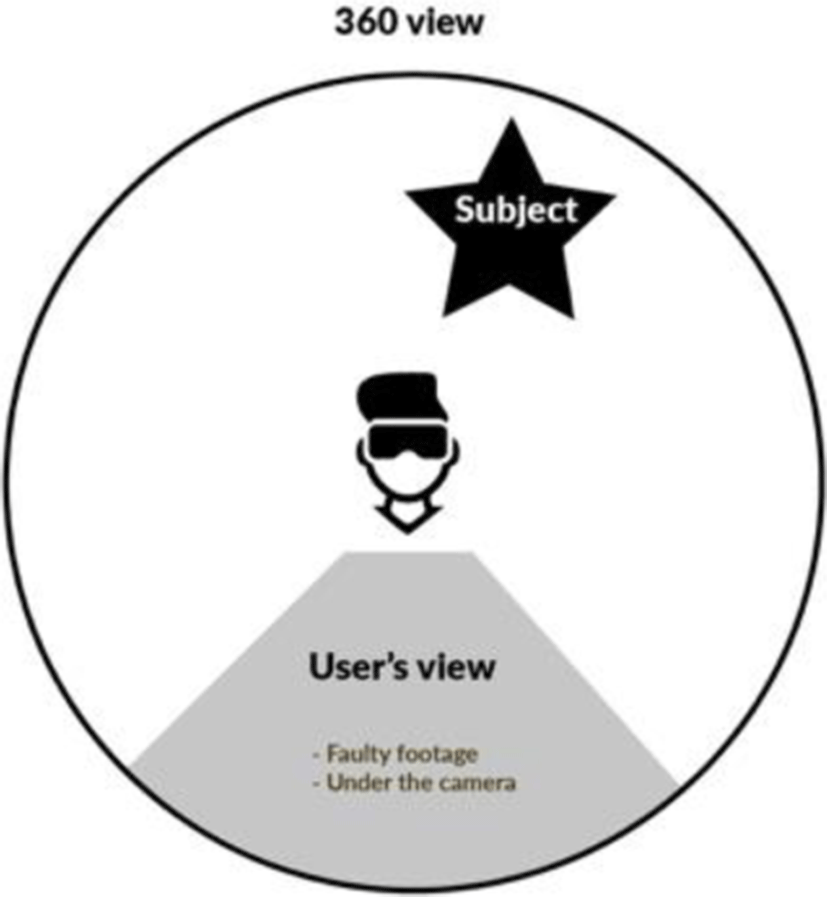
Another problem is that the proximity with a subject can be uncanny, so emotional scenes can end up being awkward or even disturbing. This happens in <Waves of Grace 2015>, where main character Decontee Davis is crying and the viewer is placed extremely close to her (see Figure 5), but is ultimately unable to console her, generating an uncanny experience [5].
Other inconsistencies can occur in the moment of recording itself. 360° cameras and the resources to edit them are of relatively recent development, generating specific issues that might be difficult to solve. These technical details can contribute to an uncomfortable experience for the viewer and frustration for the creators that want to convey a specific message. These cameras commonly have two lenses, one on each side of the camera, and they record together, forming a 360° video. Sometimes, they are unable to register what is in between them with 100% accuracy (See Figure 6), causing details that are impossible to remove in post-production, or that need “stitching”, a technique where the editor tries to blend the footage together so that it looks smooth and natural.
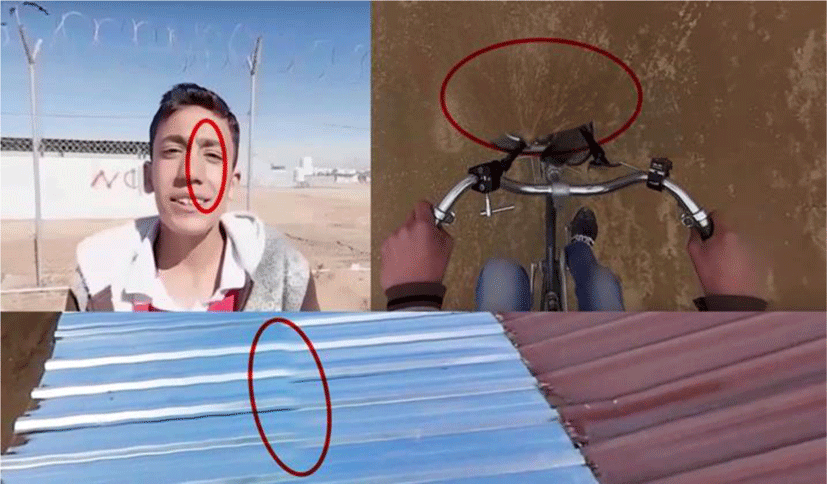
IV. VR: EMPATHY AND IMMERSION THROUGH BODILY PRESENCE
The assumption that more immersion means more empathy, as coherent as it sounds, has proven to be a hard statement to be validated as a true fact. Empirical research on the subject is not abundant, but some have been able to gather data on relevant aspects of VR videos. The journalism field is particularly interested in these developments, and newspapers such as The New York Times and VICE News have been making use of 360° videos to bring attention to various issues. [6] Some empirical studies focus specifically on the relation between journalism and immersion, they analyze if VR helps as an information tool. However, most studies surrounding this matter end inconclusive, such as Jones (2017) [7] and Van Damme, All, De Marez and Van Leuven (2019) [8], but they still don’t disregard the empathy factor of VR. The latter one targets the feeling of “distance suffering” with VR, something that strongly relates to what humanitarian communication hopes to generate. It has not, however, found any data that supports the claim that VR can create “distance suffering”, that means, the feeling of suffering for someone that is far away from oneself. Differently than the videos mentioned in this article, it did not include a “call for action”, being unable to range the aftereffects of the empathy in VR research.
On the other hand, Archer and Finger (2018) [9] were able to gauge more determinant results. In their study, the users experienced a story through different means, through text, 2D Video, 360° Video and VR with a head-mounted display. The VR formats prompter a more empathetic response than the other types, and VR users stated having a higher level of immersion. One of the most notable findings was that the users that experimented VR were more prone to report a “desire to take action”, and had an easier time recalling the stories they’d seen. It’s also interesting to note that the story with a female protagonist scored slightly higher in the empathy section than the other videos, which is correspondent with the large number of women that are protagonists in humanitarian film, a technique used to make the narrative resonate more with the public.
Even with all of these advantages in immersion, VR and 360° videos lack engagement when compared with non-VR videos online [10]. The novelty factor can make the experience very attractive in the beginning, but problems such as motion sickness and physical discomfort can outweigh the excitement over the sense of ‘presence’ with time.
V. VR AND NON-VR: TWO DIFFERENT SPACES
It is difficult for VR non-fiction to keep the public’s attention for longs periods of time. The videos are short, with an average of 6 minutes and 39 seconds, usually lasting no longer than 10 minutes [7]. This is due not only to motion sickness, but to possible boredom due to lack of stimuli. Despite the discomfort caused by the head-mounted display, VR does bring more spatial immersion than non-VR. However, this advantage is one of the causes of VR’s non-fiction hardest to reach point: emotional immersion, which is only possible through interesting and engaging storytelling. This is equally important to spatial immersion and should be combined with it to lead to an “ultra immersion” [11]
In non-VR media, there is a distance between the viewer and the screen and they see exact angles chosen by the directors. In VR, the viewer is “bodily present”, and can, even if with limits, choose where to look. In this sense, VR’s world, where the user is inserted, contrasts with the ‘world represented and viewed’ of documentary film. From this main disparity comes many variations, and most of them will change with time as VR technology evolves. They are delineated on comparison Table 1, adapted from Calo (2016) [12], Wiehl (2018) [13] and Wang, Gu and Suh (2018) [10].
Interestingly, VR’s advantages are what generate its disadvantages. Another factor caused by the power of looking is the overwhelming fear of missing out (FOMO) [7]. The “multiple story space”, made by the natural action of moving one’s head, has to be somewhat controlled by the creators. Viewers are guided in non-VR by what the director chose to show onscreen. In VR, they have to be directed with sounds or visual indicators of where to look. It sounds contradictory, but otherwise, the storytelling will rely solely on the shooting spots.
While non-VR documentary still seems to have an advantage on storytelling over VR ones, there are many advantages to using VR when more than just the power of looking is available to the viewer. For instance, in the VR Documentary <The Enemy 2017> (See figure 7) the “viewser” (term coined by Dan Harries meaning a conjunction of viewer and user) [2], can hear stories of different sides of war conflicts while staying between two soldiers that are against each other. In the VR-version of this documentary, featured only in exhibition spaces, the visitor has to first answer a 15 item questionnaire to then watch a personalized version of this “participative documentary”. This is a good example of how VR can also place people in tense situations, where just the act of walking to one side or another makes you choose who you’ll listen to. The loss of linearity, in this case, enhances the documentary storytelling capability, fitting a first-person perspective. This is, however, a more “virtual” experience than the other VR documentaries mentioned in this article, since it features 3D characters modelled after real people and a 3D modelled room, instead of raw footage.
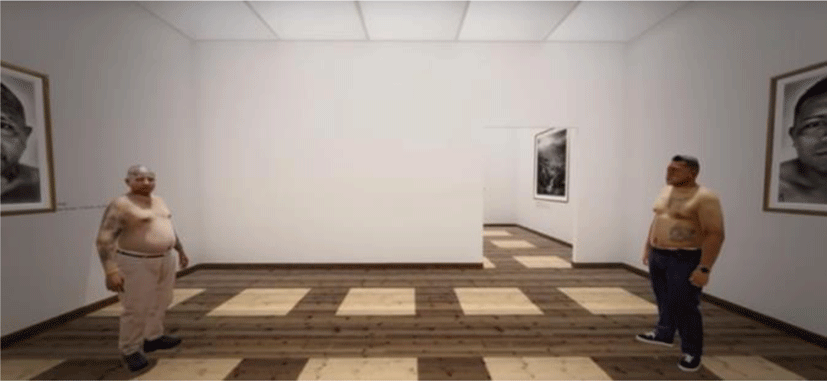
There are many difficulties to creating non-fiction VR video, and this participatory characteristic could be a solution to some of them. When filming with a 360° camera, the creative process “becomes a hybrid between theatre and cinema” [14]. In theatre, the director has to be aware that everything on stage will be seen by the public. It works similarly in 360°, what is not supposed to be seen has to be hidden somewhere the field of view of the camera can’t reach. All of the storytelling workflow changes, and has to be adapted to this new form of media. Lightning, camera position, camera configuration and choice of lens have different rules as well, but since this is a somewhat recent device, it needs time to be established as a mainstream sort of media.
VI. CONCLUSION AND FUTURE WORK
Non-VR documentaries are still the majority, but these recent experiments with the use of VR for humanitarian communication are important for the future of this media, and demonstrate the search for empathy that creators hope to induce in the audience. The VR industry is growing in many different fields, but it can still be perceived as early cinema in non-fiction. It relies too much on VR technology as a novelty, lacking storytelling complexity and, therefore, audience engagement. Nevertheless, this is already changing with the fast coming of new humanitarian productions that try to explore more of the features VR’s ‘bodily presence’ has to offer, such as <The Enemy 2017>. The uncanniness of VR, while still present, has been reduced if compared with 5 years ago. Every year, the head-mounted displays are made more comfortable and are upgraded to make it possible for users to spend longer periods of time wearing one. In the future, it is hoped that using a head-mounted display will be even more natural and seamless. But in the end, VR, however exciting it is, shouldn’t be expected to be a utopian sort of media that can solve all problems concerning empathy.
Empirical studies on VR non-fiction are still not completely accurate in their methods and will need time to develop, due to the technology as it is today being so new. Another factor that limits the reach of VR for further studies is the inaccessibility of the product due to its price. Cheaper mobile head-mounted displays are available, but they lack the quality of famous brands such as HTC Hive and Oculus Rift. Technology enthusiasts might buy the computer versions, that are more comfortable and have reduced motion sickness, however, these products still need to have their price lowered and become normalized for more smooth analysis to be possible. VR non-fiction filmed with a 360° camera that possesses no interaction factor has a harder time with engagement than environments that are virtually created through computer graphic software. The ability to walk that is given in these virtually generated environments is a compelling feature that the videos cannot reproduce. As such, VR non-fiction directors must learn to create their own new forms of presenting facts in an appealing way, create their own filming methods, and try to use the technology to enhance the virtual reality experience.
This study was part of a work in progress masters’ thesis on VR non-fiction titled ‘Tourism, History and Immersion: Understanding the World Through VR Non-fiction’. In this paper, the analysis of humanitarian documentary, as one of the most morally sensitive types of media, served the purpose of not only understanding the advantages of filming in VR, but how to use it to the best of its abilities in non-fiction. In addition, the material studied here is being applied on the development of a VR documentary, an experimental project that is a segment of the thesis.

